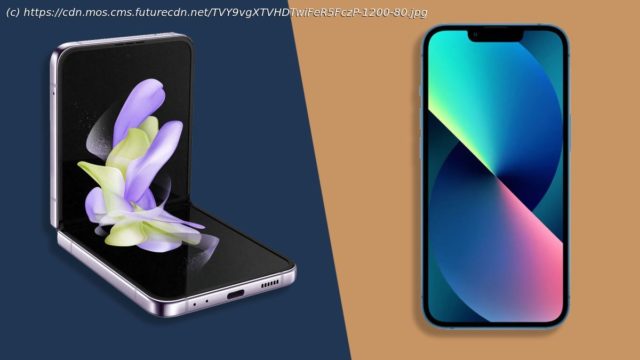Just how badly does Samsung’s new Z Flip 4 foldable show up Apple’s iPhone 13, if at all?
After 2021’s Galaxy Z Flip 3 broke foldables out into the mainstream, Samsung is expecting big things of the Galaxy Z Flip 4. But is it ready to tackle the overall smartphone champ, the iPhone 13?
Apple’s most popular phone is the perfect barometer by which to judge whether the Galaxy Z Flip 4 among the best phones, or remains reserved to the collective of best foldables.
The Samsung Galaxy Z Flip 4 is on sale from August 26 in the US and UK, and September 2 in Australia. Pricing starts from $999.99 / £999 / AU$1,499 for 128GB, moving up to $1,059.99 / £1,059 / AU$1,649 for 256GB. This year, there’s also a 512GB model, which costs $1,179.99 / £1,199 / AU$1,849.
Then we have the iPhone 13, which arrived in shops on September 24, 2021. Prices start from $799 / £799 / AU$1,349 for the base 128GB model, moving up to $899 / £879 / AU$1,519 for 256GB build and $1,099 / £1,079 / AU$1,869 for 512GB variant.
It’s not often that Apple phones look like a bargain, but the iPhone 13 is significantly cheaper than its collapsible counterpart.
Both of these phones look a lot like their immediate predecessors. That’s no bad thing, however, when you’re dealing with two iconic designs.
The Galaxy Z Fold 4 is a clamshell flip phone that unfurls into a full-sized handset. Its flat sides faintly remind us of the iPhone 13, but Samsung’s distinctive two-tone rear finish sets it apart. This includes a bold range of colors set off by a black ‘visor’ effect covering the camera module.
Apple’s iPhone 13 needs no introduction, with a focus on sharp, completely flat surfaces that has reconfigured the entire smartphone industry. Like we already said, even Samsung isn’t immune to the influence.
At 165.2 x 71.9 x 6.9mm when unfurled, the Galaxy Z Flip 4 is taller and slimmer than the 146.7 x 71.5 x 7.65mm iPhone 13, but also fractionally wider. At 187g vs 174g, Samsung’s foldable is a little heavier too.
Samsung covers its phone with Gorilla Glass Victus Plus, while the iPhone 13 uses a custom Ceramic Shield that mixes nano-ceramic crystals into the glass. It’s supposedly tougher than any standard display glass.
Apple also wins points for its IP68 certification, which means that it’s similarly water resistant but way more dust-resistant than the IPX8 certified Galaxy Z Flip 4.
Apple and Samsung take very different approaches to biometric authentication. The iPhone 13 has Apple’s advanced Face ID system, while the Galaxy Z Flip 4 used a rather old-fashioned side-mounted fingerprint system.
Both are tried and tested solutions, and the ‘winner’ partly comes to personal preference. Apple’s Face ID system – while being 20% smaller than before – is far more intrusive than Samsung’s subtle hole punch notch.
The Samsung Galaxy Z Flip 4 might be a tiny square of a thing in its closed position, but it folds out into a full-sized phone. Indeed, its 6.7-inch display is more comparable in size to the iPhone 13 Pro Max’s screen than to the iPhone 13’s 6.1-inch example.
Both are AMOLEDs, so they’re similarly vibrant and color-accurate. However, the iPhone 13’s screen is a little sharper, with a resolution of 2532 x 1170 to the Samsung’s 2640 x 1080. Given the difference in size, that translates to a 460ppi density for the iPhone, and 426ppi for the Flip 4.






